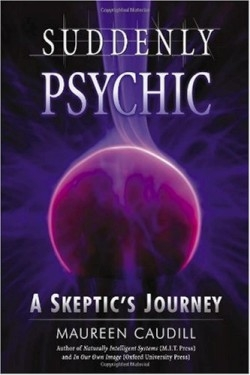Suddenly Psychic
A Skeptic's Journey
An intense spiritual awakening takes this die-hard pragmatist author by surprise. Caudill, who has a master’s in physics from Cornell and years in computer science research on neural networks, finds herself suddenly talking to the dead mother of a cherished friend, conversing with her cat, and eventually merging with the essential “Beingness” that underlies everything in the universe, a massive wall of golden light. For Caudill, the crumbling of her deeply held beliefs doesn’t happen step by step. She is flung into the outer regions of the unimaginable during a retreat at the Monroe Institute, where, as she states, “my faith in scientific views of the world had been shaken at its very foundation.”
Yet what had drawn this author of scientific articles and books, such as Understanding Neural Networks and Naturally Intelligent Systems, to the Monroe Institute was the empirical evidence underlying the technology used to induce altered states of awareness. The Institute employs a device known as Hemi-Sync, using “binaural beats,” complex frequencies given through headphones that allow humans to “hear” signals well out of the range of normal hearing. These frequencies are associated with “Focus Levels” of awareness, from basic waking consciousness all the way to the “Mind of God.” Caudill states that: “the technological and scientifically validated aspects (of the program) acted like the Good Housekeeping seal of approval to my logical, rational brain.”
Though curiosity about the science of this technology intrigued her enough to sign up for the initial retreat, she tumbles down the rabbit hole once she enters the core program, even performing “soul retrievals” of people who had died and had gotten stuck. Before her experiences at the Institute, the author had never considered life after death a possibility. She always believed that “when you’re dead, you’re dead.” However, her continued work at the Institute yields information later found to be true, such as specific facts she receives from the deceased mother of her friend, and she is left with the task of either rewriting her whole system of beliefs or checking into the nearest psych ward.
Paradoxically, Caudill’s skepticism keeps her in the program, nibbling away at the edges of her experiences to find something, anything, that is verifiable, that would stand up to the rigor of scientific experimentation. What she finds are places where the very solid science of physics and the very subtle science of mysticism intersect, where these two disciplines “may at last be on a converging set of tracks, rather than the diverging ones they’ve been following for centuries.”
One of the more poignant experiences the author recounts is her soul retrieval of the crashed European Spacecraft Beagle Lander on Mars. In one of her sessions with the Hemi-Sync frequencies, Caudill encounters the Beagle, a machine that “desperately wanted to fulfill its mission satisfactorily” but its antennae were crumpled and it couldn’t signal Earth. The author communicates with small Lander and takes it to a frequency level that appears to be a graveyard for machines. Leaving the Beagle Lander there, she reflects for some time on why she was guided to this particular task in a frequency level that other people in the research program seldom visited, and concluded that her work on artificial intelligence had not only prepared her for such an encounter, it resonated with a statement in her 1992 book on artificial intelligence, In Our Own Image: “sooner or later, our robotic creations, intelligent or not, will cross an unknown divider line and become conscious, aware personalities.”
The science in this book is both utterly accessible and impeccable. Though it is complex, the author presents it in terms the reader can grasp. For example, in examining how to define a “mind,” she uses her own background of neural networks to build a case for the heart having its own mind: “There are exceptionally large clusters of extra-brain neurons located in the heart.” In the appendices, the author lists source documents that readers can check and is candid about the more controversial scientific studies examining “subtle energies.” For anyone who was intrigued with the movie What the Bleep do we Know, as well as for readers wanting hard evidence of the study of subtle energy, this book is a treasure, and is thoroughly satisfying for people who are simply curious about the experience of becoming “suddenly psychic.”
Reviewed by
Carol Lynn Stewart
Disclosure: This article is not an endorsement, but a review. The publisher of this book provided free copies of the book to have their book reviewed by a professional reviewer. No fee was paid by the publisher for this review. Foreword Reviews only recommends books that we love. Foreword Magazine, Inc. is disclosing this in accordance with the Federal Trade Commission’s 16 CFR, Part 255.

